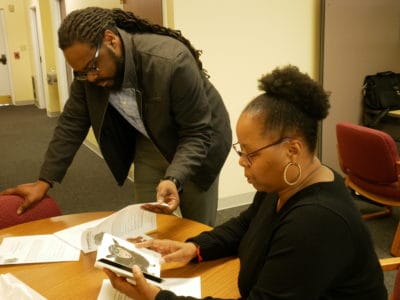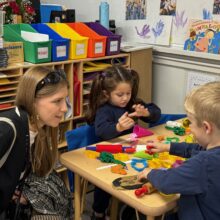When teachers get really good, they often stop teaching.
After years in the classroom, the desire to move onto something with higher pay, more responsibility, and greater challenge is understandable. When that time comes, Public Impact is hoping to give teachers a meaningful alternative to transitioning into administration.
“We’re losing some really excellent teaching in schools,” said Shonaka Ellison, a consultant with Public Impact.
That’s where an “opportunity culture” comes in. Ellison is working closely with Edgecombe County administrators and teachers to restructure the teaching staff of three of the district’s schools: Coker-Wimberly Elementary, Phillips Middle, and North Edgecombe High.
In 18 sites across the country and three other sites in North Carolina, opportunity cultures have been implemented, creating career pathways for ambitious teachers and maximizing their talent. Public Impact recently announced Vance County as their newest opportunity culture site.
Educators from around the state are sharing techniques from district to district. Teachers and administrators from Edgecombe County have visited with Charlotte-Mecklenburg to see the model in action. And Vance County staff has now visited with Edgecombe County educators to observe their early stages of planning.
Lucy Steiner, senior vice president of professional learning and leadership at Public Impact, works nationwide to bring this model to school districts.
“The whole premise of an opportunity culture,” explained Steiner, “is to extend the reach of excellent teachers to more students.”
That can look different depending on what the school decides is best for its teachers and students. First, the schools go through an extensive planning process, where they decide what positions would provide the best outcomes for everyone involved. It’s intended to be sustainable, working to reorganize the school’s budget instead of relying on one-time grants or limited funding streams.
Then, any person — internal or external — can apply for those positions. Steiner said, nationwide, there’s a good deal of both internal and external hires.
Sometimes, a teacher will take on more students. But Steiner said that doesn’t mean the teacher’s class size gets bigger.
“You basically give this great teacher the resources that can allow them to reach more students,” she said.
Through digital learning labs and the use of paraprofessionals that Steiner calls “reach associates,” she said a teacher’s impact can stretch 33 percent further.
That’s the case for fifth-grade teacher Caitlin Zancanaro who works at Lake Wylie Elementary in Charlotte, a school in its first year implementing an opportunity culture. Right now, just the fifth grade has been restructured with hopes to expand the design to other grades.
Zancanaro, in an interview with EducationNC, said she went from teaching around 30 students to 121 students this year. Instead of working in self-contained classrooms where a teacher would teach every subject, each fifth-grade teacher is sticking to what he or she knows best, according to EVASS scores. Zancanaro’s evaluation shows she exceeds growth in math, so she now teaches four blocks of only math per day.
“We’re all teaching to our strengths, which has been really beneficial,” Zancanaro said.
Lake Wylie also placed all fifth-grade exceptional children together in a class, along with all gifted students in another class, and all English-language learners in another. That way, teachers that can reach the specific needs of those students can co-teach with Zancanaro.
“I have push-in support in my class, so I’m able to spend quality time one-on-one for each student,” she said. “They’re constantly getting support and information from both of us.”
Zancanaro said mid-year benchmarks have shown students are growing — especially EC and ESL students. And, as a professional, Zancanaro said she is growing too.
“It’s the most challenging thing that I’ve done in my teaching career because every class or students is so different and their needs are so different that you have to tailor the craft of teaching and tailor your instruction to be effective and to meet the needs of those students,” she said.
The other option is to create positions called multi-classroom leaders. That’s when a teacher leads a team of other teachers. Steiner said this is different than a traditional instructional coach in a few ways.
For one, the teams are usually smaller. The job description for each multi-classroom leader has a limit on how many teachers can be on one team. Steiner said this gives the leader an opportunity to work more closely with the teachers and their students and respond to their specific needs.
“The teachers are in their classrooms daily, and co-teach with them, model with them, sometimes write their lesson plans — anything that’s needed by the teachers on that team, they’re ready to step in and help with,” Steiner said.
Another big difference from a coach is that the multi-classroom leader is held accountable for the students’ results. How that works is unique to that state’s accountability system. In Charlotte-Mecklenburg Schools, multi-classroom leaders are responsible for teachers’ evaluations and students’ performance.
Sean Carberry is a multi-classroom leader over fourth and fifth grades at Charlotte’s Montclaire Elementary. Carberry said he pulls out select students, depending on whoever needs extra help, to work with them in small group settings. He also does a lot of team teaching, provides feedback for teachers, and occasionally models for newer teachers.
Carberry used to be a classroom teacher before moving to multiple different facilitator and administrative roles. In the six months that Carberry has spent in this position, he’s been able to get the best of both worlds.
“I was getting very much removed from the interactions and the teaching of young children,” Carberry said.
As a multi-classroom leader, Carberry can build the capacity of teachers — a job he still loves — and continue to build relationships with students.
As a teacher in a Title 1 school with around 95 percent of its students receiving free or reduced-price lunch, Carberry said an opportunity culture is especially important.
“In schools like this, we do have a large turnover rate,” he said. “Having and retaining quality educators allows sustainability in the growth of the school.”
Ellison said this work is particularly meaningful in Edgecombe County, which also has schools with high poverty and high teacher turnover — but also faces the challenge of being rural, unlike Charlotte schools.
“For a place like Edgecombe County, that’s really rural, having this type of career opportunity for teachers will help draw more teachers to the district,” she said.
Recommended reading




